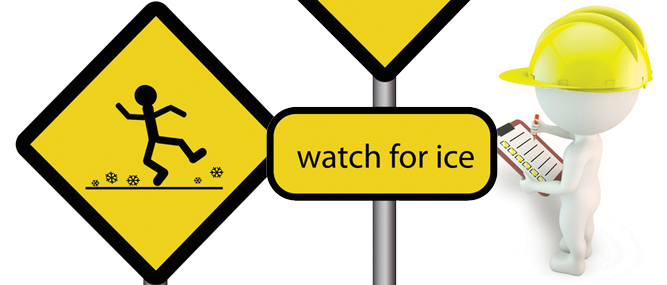When it comes to employee safety training, slip, trip, and fall prevention can never be over emphasized. And winter is the perfect time to focus on this area because cold weather conditions tend to make these challenges worse. It is important to include all of your staff in slip, trip and fall training because everyone could be at risk.
Usually slip, trip and fall incidents can be prevented if people are aware of the risks and take the proper steps to avoid hazardous situations. Accidents resulting from slips, trips and falls are often very costly, especially when you add up all the claim costs, the additional labor, the time and production losses, and the increases in the employer’s worker compensation rates. Plus, the overall injury costs, pain and stress on the employee and their family cannot be measured. Unfortunately, most of these accidents result in head injuries, back injuries, broken bones, dislocations and other debilitating injuries. And as a result, these type of injuries usually require extended recovery time.
According to The Bureau of Labor and Statistics (BLS), slips, trips and falls continually account for about 15% of all worker compensation costs.
In 2012 the BLS report for the selected occupations shows a range between 18-30% of all incident rates to be slip, trip and fall related. See Table 1.
In 2013 these accidents accounted for 15.86 % of all fatalities. Granted, out of the 699 fatalities in 2013 many of these fatalities were the result of construction falls from upper levels and heights, but as you can see, on the BLS report 15% are the result of falls to the same level. See Table 2.
Poor housekeeping practices are often the root cause of a slip, trip or fall. Worksite inspections frequently reveal employees working in and around scraps, dust, sawdust, debris, extension cords, air hoses, and other trip hazards that are creators of a future accident. Good housekeeping practices will certainly reduce exposures, but it is not surprising to hear workers say, “We’re too busy to stop and clean up.” In other words; production deadlines are more important, than good housekeeping and injury prevention. Most safety experts agree that a clean and well organized workplace, is a more productive workplace.
It goes without saying, winter weather and temperatures are huge factors in slips, trips and fall incidents. Every winter employees are seriously injured because of falling on ice. Often they are involved in a simple task such as dismounting equipment. Then, they walk on wet and icy floors, parking areas and roads, and you have a real recipe for injury.
Hazard Areas Concerning Possible Slips, Trips or Falls
• Wet floors
• Building corridors, and entry areas
• Heavy foot traffic areas
• Near doorways where people or equipment pass through
• Snow melting from vehicles on concrete
• Water on oil spills
• Stairways
• Porches and decks
• Ramps
• Concrete walkways
• In front of overhead doors where heat has escaped under the door and creates ice build-up
• Loading ramps where rain or snow comes in
• Under eaves where ice builds up
• Near down spouts, often downspouts become frozen or are damaged
• Parking areas where the sun & hot vehicle engines melt snow
• Heavy traffic areas where snow is packed
• Low spots where puddles form, then freeze
• Areas where leaves collect or are tracked in
Ways to Help Prevent Slips, Trips and Falls
• Always wear footwear with good soles and traction
• When carrying items on slippery surfaces, try to keep one hand free for obtaining handholds and balance.
• When two hands are needed for carrying items, don’t carry too much at one time, if needed, make an extra trip.
• Always use railings or handholds whenever possible
• Use ice melt, salt, or gravel to make walk areas safer. Have employees assigned to monitor the hazards and perform this task.
One of the most important discussions involving the prevention of slips, trips and falls is how to safely mount and dismount equipment, and getting in and out of vehicles. The following preventative tips should be reviewed:
• Move slowly while transitioning in and out of vehicles and equipment.
• Take your time, warm shoe soles are very slippery on ice, always stand for a moment before walking from your equipment, or vehicle.
• Running boards are often very hazardous due to ice and snow build up.
• Keep the treads and steps free of ice and snow build-up on your equipment.
• Always maintain three points of contact whenever entering or exiting vehicles or equipment. Example: two handholds on the vehicle, and one foot on the ground while the other foot is in motion. See illustration on page 41.
Slip, trip and fall prevention should be a topic for your next employee
safety training session. As part of the meeting, have your safety committee or employees take a walk around the
workplace to identify hazards. This is the best time to remedy the problems. This impromptu self-inspection is the best time to fix those broken downspouts, fill those low spots that will soon be ice rinks in your parking area, remind your staff of the importance of good housekeeping, and replace worn or damaged equipment treads and steps.
Editor’s Note: Jary Winstead is a safety consultant, author and trainer who serves a variety of industries including the forest products sector. He owns Work Safety Services LLC and can be reached at SAFEJARY@aol.com.




